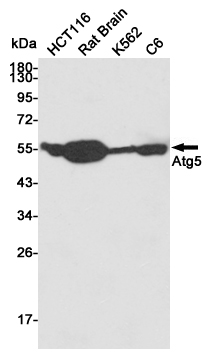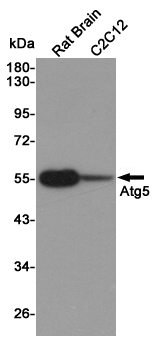-
Product Name
Anti-APG5L/ATG5 (8F1) Mouse antibody
- Documents
-
Description
APG5L/ATG5 (8F1) Mouse monoclonal antibody
-
Tested applications
WB
-
Species reactivity
Human, Rat
-
Alternative names
APG 5;APG 5L;APG5;APG5 autophagy 5 like;APG5 like;APG5-like;APG5L;Apoptosis specific protein;Apoptosis-specific protein;ASP;ATG 5;Atg5;ATG5 autophagy related 5 homolog;ATG5_HUMAN;Autophagy protein 5;hAPG5;Homolog of S Cerevisiae autophagy 5;OTTHUMP0000004 antibody
-
Isotype
Mouse IgG1
-
Preparation
Antigen: Synthetic peptide.
-
Clonality
Monoclonal
-
Formulation
Purified mouse monoclonal antibody in PBS(pH 7.4) containing with 0.03% Proclin300 and 50% glycerol.
-
Storage instructions
Store at 4°C short term. Store at -20°C long term. Avoid freeze / thaw cycle.
-
Applications
WB: 1/1000
-
Validations

Western blot detection of Atg5 in HCT116,Rat Brain,K562 and C6 cell lysates using Atg5 mouse mAb (1:1000 diluted).Predicted band size:55KDa.Observed band size:55KDa.

Western blot detection of Atg5 in Rat Brain and C2C12 cell lysates using Atg5 mouse mAb (1:1000 diluted).Predicted band size:55KDa.Observed band size:55KDa.
-
Background
Swiss-Prot Acc.Q9H1Y0.Required for autophagy. Conjugates to ATG12 and associates with isolation membrane to form cup-shaped isolation membrane and autophagosome. The conjugate detaches from the membrane immediately before or after autophagosome formation is completed By similarity. Ref.6May play an important role in the apoptotic process, possibly within the modified cytoskeleton. Its expression is a relatively late event in the apoptotic process, occurring downstream of caspase activity.
Related Products / Services
Please note: All products are "FOR RESEARCH USE ONLY AND ARE NOT INTENDED FOR DIAGNOSTIC OR THERAPEUTIC USE"
